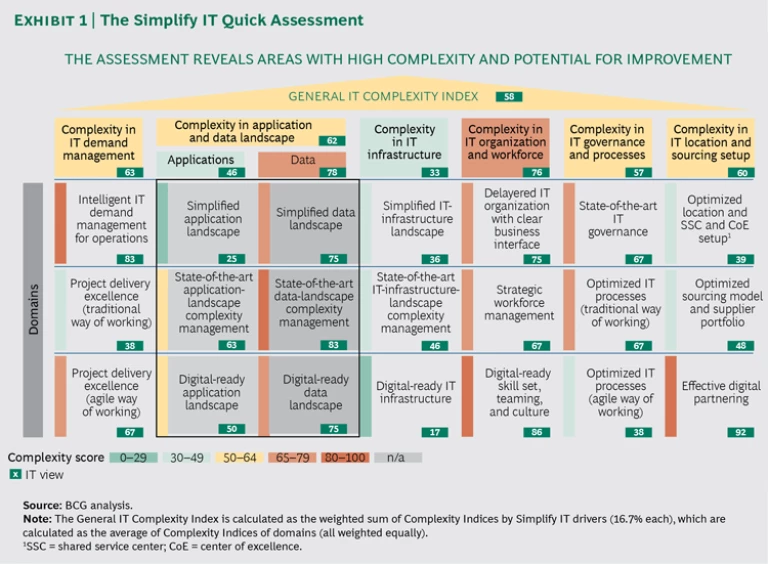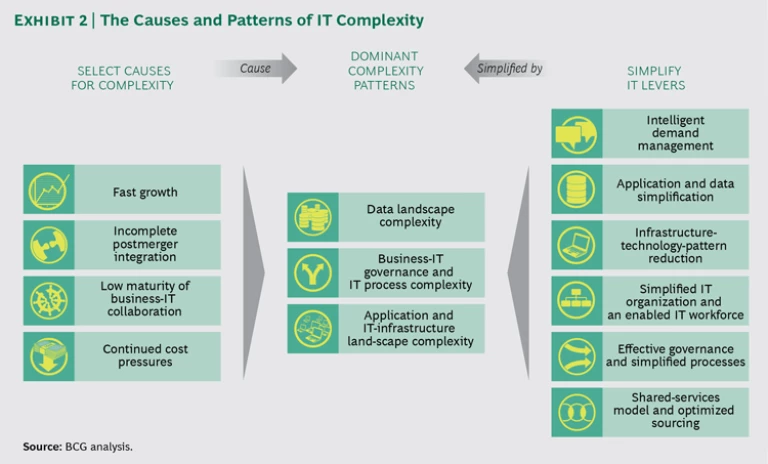Corporate IT functions are being hit with a one-two punch. Digital technologies increase the need to adapt ever more quickly to disruptive new applications and services. Those technologies also create rising customer expectations. For B2C companies, disruptive innovators—such as Airbnb, Simple, and Uber Technologies—continuously roll out new models and services, and each one raises the competitive bar. They also teach consumers to expect more from all the other companies that they do business with. In the B2B sector, innovative entrants such as Alibaba.com and Mercateo enable companies to create entirely new value chains and propositions.
To fight back, traditional companies need to become much more agile, by shortening time to market and delivering IT services more quickly; flexible, by scaling IT volume up and down quickly, for example; and efficient, by reducing IT costs. Simplifying IT is an essential task for any IT organization that wants to stay competitive. It is also a critical foundation for digital transformation . This article analyses the causes and patterns of IT complexity, examining two routes that companies can take to eliminate complexity and prepare for a digital transformation that is based on The Boston Consulting Group’s (BCG’s) Simplify IT approach. Part of the Smart Simplicity framework, Simplify IT employs six levers that can be applied individually or in combination, depending on any given company’s needs. (See Simplify IT: Six Ways to Reduce Complexity , BCG Focus, March 2013.)
Complexity and Digital Transformation
In a perfect world, IT simplification and digital transformation go hand in glove. Simplifying IT helps a digital transformation succeed: it is far easier, for example, to develop new digital services in a “clean” IT landscape—with a reduced number of applications, interfaces, and technologies—than in a complex one. At the same time, a digital transformation offers opportunities to simplify IT and allows CIOs to take advantage of a significant investment budget along with strong buy-in from the business function and commitment from top management. (See “ Digitization and Simplification ,” BCG article, December 2014.)
The CIO of ING Bank put it this way: “We decided that since we were investing a lot in the simplification of our landscape and the consolidation of data centers, platforms, operating systems, and middleware—and since we were looking at a three- or four-year journey anyway—we should do all of the above: build a new digital platform that was cloud-based and API-based, and Web scale at the same time.” (See “ Building a Cutting-Edge Banking IT Function ,” BCG article, December 2015.)
That said, we continually encounter companies whose failure to address IT complexity hampers or substantially slows their digital-transformation programs. This is both unfortunate and unnecessary. We have developed a clear methodology for simplifying IT that is suitable for any kind of company; even companies that are not undertaking a full-scale transformation will reap substantial savings and facilitate the application of digital technologies from a simplified—and more agile, flexible, and efficient—IT operation.
Simplify IT’s Six Levers
The following are the six levers for simplifying IT:
- Intelligent Demand Management. This helps business units develop a clear understanding of the IT resources—and cost drivers—that are needed to keep day-to-day IT operations running and to take on new projects, so managers can maximize value with informed decisions, effective resource allocation, and efficient use.
- Application and Data Simplification. Companies look for ways to consolidate and decommission applications and clearly define interfaces—or replace them with less complex alternatives—and to simplify the data landscape.
- Infrastructure-Technology-Pattern Reduction. Companies embrace opportunities to minimize the number of unique configurations of hardware and software, including middleware and databases, and to automate deployment, such as through standardization.
- Simplified IT Organization and an Enabled IT Workforce. Companies can remove bottlenecks by trimming management layers, optimizing spans of control, and ensuring an effective interface between the business function and the IT department. They can also ensure that the IT staff is an appropriate size and that staff members have the requisite expertise and digital skills, such as mobile development and user- experience design.
- Effective Governance and Simplified Processes. Good governance models position IT as a strategic partner of the business unit while streamlining IT processes. IT functions can also leverage agile methods, such as scrum, to speed up application development.
- A Shared-Services Model and Optimized Sourcing. Companies pool demand for both external and internal resources as needed and establish a sourcing model tailored to the strategy and requirements of the organization.
We recently analyzed some 500 Simplify IT projects and about 50 Simplify IT quick assessments performed by BCG over the past three years. (See Exhibit 1.) The quick assessments were based on a questionnaire that includes quantitative and qualitative questions, from both an IT and a business perspective, on each of the six levers. Each response was given a complexity score ranging from 0, for low complexity, to 100, for high complexity. The analysis helps companies that are evaluating their IT simplification needs to focus on three key issues:
- The typical root causes of the complexity, both within the IT department and at its intersection with the business function.
- The complexity patterns that emerge and need to be addressed.
- The extent of the effort needed to eliminate non-value-creating complexity and become more agile, flexible, and efficient—as well as speed up digital transformation.
Common Causes of IT Complexity
Our analysis pinpoints four major root causes of IT complexity, each growing out of companies’ particular situations.
Fast Growth. To facilitate rapid business expansion at fast-growing companies, IT often employs hastily constructed, short-term, or siloed solutions that do not scale easily. New functionalities are implemented quickly, but they are not always efficient because they increase the number of point-to-point connections or satellite applications. This is especially true for companies that rapidly develop decentralized digital services and fail to align them with existing architecture. (See Recasting IT for the Digital Age , BCG Focus, March 2016.)
Incomplete Postmerger Integration (PMI). As companies grow through acquisition, IT functions are not always fully integrated during PMI, which can lead to significant redundancies. These redundancies, and the frequent absence of automatic interfaces between systems, also make it difficult to implement digital end-to-end services.
Low Business-IT Collaboration. Many companies—however unintentionally—grow IT complexity by employing an old-fashioned business-IT collaboration model. This is especially true of companies that historically have considered IT as a support function rather than as a partner to the business. Such companies tend to wait until late stages of a project before involving the IT department. They also follow the classic waterfall development process. What’s more, the business function, which pays for IT services, considers itself the sole decision maker and believes that it can sidestep or ignore process and architectural guidelines. As a result, new requirements disrupt existing application landscapes and processes, leading to a wide variety of different technologies employed for similar functionality. We also find that in such organizations the IT department does not have up-to-date skills and has not adopted new ways of working, such as agile—two shortcomings that undermine its ability to add value and be perceived as a partner.
Cost Pressures. As growth slows or markets plateau, companies come under strong cost pressures that are reflected in both the business and the IT functions. This can lead to underinvestment, meaning that business requirements tend to be met at the lowest cost, with no consideration given to related complexity increase and project follow-up costs. At the same time, digital transformations can lead to even higher IT costs, at least in the near term.
Common Patterns of IT Complexity
These causes lead to three common complexity patterns: data landscape complexity; poor business-IT governance and IT process complexity; and application and IT-infrastructure landscape complexity. (See Exhibit 2.) Not surprisingly, the extent and nature of each varies by both company and industry. Financial-services companies have greater experience with managing these types of complexity and thus handle them better. For example, most banks and insurance companies, which started to renovate their IT landscapes several years ago, score 13% better overall than other companies.
Data Landscape Complexity. Companies struggle more with data landscape complexity and data landscape management than any other issues. Approximately half of the companies in our sample scored lowest in this area. Data simplification requires uniform definitions and common standards for enterprise-wide data objects (pieces of information that are relevant to the entire company), but we found that such definitions and standards are often only partly specified; this was the case for 45% of companies. In addition, only about 10% of companies have established a “single source of truth” for their data, that is, unique storage spaces, or databases, for enterprise-wide data objects. The lack of standards and multiple databases can lead to serious problems: inconsistent data, such as data from multichannel customer engagements, hobbles the ability of data analytics programs to analyze customer behaviors and deliver digital services.
Many companies also lag in establishing clear data-management and governance policies and practices, such as defining a clear target-data landscape and establishing a central and overarching data-management role within the organization. These are important foundations for data-simplification programs. Good practices include implementing state-of-the-art data quality and security management processes and prioritizing the performance of such processes on both the business and IT agendas. Clear data-management and governance policies are not IT-only tasks; the entire business organization needs to own them.
Business-IT Governance and IT Process Complexity. The complexity of business-IT governance and IT processes was rated high or medium (at least 50 on our 100-point scale) by 60% of the companies that participated in the assessment. This pattern is common in companies with low business-IT collaboration and appears mainly in organizations where IT is seen as a service provider—a “butler of the business”—rather than as a strategic partner. The business-IT interface usually does not follow an established process (much less best practice); instead it takes the form of a complex set of ad hoc and decentralized interactions. This typically results in redundancies and workaround solutions. New business functionality is not weighed against the incremental complexity it inevitably adds to the application landscape and IT processes, such as numerous interfaces and increased testing efforts, which reduce speed and agility for the company as a whole.
Complicating matters further, if IT development processes are perceived as slow and bureaucratic when it comes to implementing new business requirements, impatient businesses try to either shortcut those processes by reaching out directly to developers to get things done more quickly or start building their own solutions, a phenomenon often referred to as “shadow IT.” This multiplies the complexity increase and compounds the problem, especially when solutions that do not comply with the overall IT architecture guidelines are employed, thus undermining digital speed or creating a security hazard—or both.
In addition, many companies do not make adequate use of agile working methods and processes. Traditional software-development methods, such as the waterfall model, tend to dominate. Although, in our experience, three-quarters of companies use some agile methods, the vast majority have only just started agile pilots: only 5% or fewer of the development teams that we encounter work in an agile mode. Introducing agile development methods and ensuring that a dedicated business owner works with the development team can significantly speed up IT delivery. (See The Power of People in Digital Banking Transformation , BCG Focus, November 2015.) Some companies might also consider applying digital to simplify IT processes—for example, by deploying code to cloud environments, fully automating delivery processes, or using robotic-process automation to monitor data center operations.
We have seen companies achieve high productivity gains through joint business-IT efforts to improve IT processes, speeding up incident management and application development, for instance, by 25% and 30%, respectively. New methods of collaboration between development and operations (such as DevOps) can speed time to market by 20%. Improving business-IT governance and thereby strengthening the role of IT and its relationship with the business—for example, by ensuring that IT has a strong role in new product-development processes and in prioritizing the IT project portfolio—is yet another way to eliminate this cause of complexity.
Application and IT-Infrastructure Landscape Complexity. The third major problem area is the application and IT infrastructure landscape, where complexity constrains companies’ ability to implement digital innovations quickly and efficiently. Nearly two-thirds of the companies in our sample evidenced weaknesses in such capabilities as developing application program interfaces and microservices for connecting new services or fostering methods such as continuous delivery (the automation of the entire application development and deployment process) or deployment.
Specific IT infrastructure capabilities required for digital services and innovations include the adoption of continuous delivery, the availability of real-time-capable infrastructure components, and the use of adequate cashing and buffering systems, such as buffer databases, to reduce latency time and processed-data volume. These are the capabilities that enable digital-native companies to use continuous deployment and other methods to release new services or software more than 100 times a day. Older, more established companies can also develop and use such resources to reduce the time for provisioning new software from weeks to days or even minutes.
One European bank furthered its digitization efforts by overhauling its application infrastructure. It designed an IT application architecture around three main domains that corresponded to three key functions: client relationships, client services, and transaction processing. The bank was able to develop applications for each domain much faster by using the most appropriate methodology in each case. It reduced the cost of developing applications by one-third while also shortening its development schedule.
Eliminating Complexity
Companies can undertake two types of IT simplification projects. The first and most far-reaching consists of comprehensive IT-simplification programs, which we define as those applying three or more Simplify IT levers. These have the potential to cut up to 30% of the total IT cost base and to substantially facilitate digital transformations by establishing a clean and decoupled IT-application landscape and by automating IT processes.
This approach, which usually involves a multiyear journey, entails a revolutionary change of the entire corporate IT function: technology, processes, and ways of working. Removing legacy systems makes room for state-of-the-art and more efficient technologies, software, programming languages, and infrastructure. Broader usage of cloud platforms, systems, and software is common. Such large-scale simplification programs generally aim to facilitate and enhance digital transformation. They are often coupled with agile transformations, at least for nonlegacy areas. To ensure maximum impact, companies undertaking full-scale simplification programs still need to address the complexity issues at the business-IT interface by forming cross-functional, feature-oriented teams to cut coordination overhead, reduce idle time, and increase agility and flexibility for application delivery.
The second approach is to focus on a particular problem or need that requires one or two IT simplification levers. Despite its relatively narrow scope, this undertaking can still have a big impact. Some application and data-landscape simplification projects have achieved savings of 15% to 20% of the full IT cost base; others have cut up to 50% of the applications-related cost base as companies were able to reduce their number of applications by 40% to 70%. In addition to the direct cost benefits, a simplified application landscape also makes it easier to connect new digital services or to implement end-to-end process automation.
Similarly, projects that focus on simplifying the IT infrastructure typically achieve cost savings of 5% to 15% of the IT budget, and companies have been able to reduce the cost of physical servers by up to 80% by increasing server virtualization and decreasing the number of different configurations. These efforts also foster the application of approaches such as DevOps and continuous delivery, which facilitate the rapid implementation of digital innovations and promote quick reactions to changing customer requirements. IT organization projects, which are frequently undertaken in combination with changes to the business-IT governance and processes, also typically achieve cost savings of 15% to 20% of the IT budget. Companies benefit from fewer skills-related bottlenecks, increased decision-making speed, and higher user satisfaction as well.
An essential success factor for all types of simplification projects is strong buy-in from business management, which must commit to actually eliminating complexity in application and data landscape, often through decommissioning redundant or rarely used functionalities.
A proven IT-simplification methodology will increase agility, flexibility, and efficiency—all key success factors in digital transformation. The challenge can appear daunting, but the tools to overcome it are available. Our process starts with the Simplify IT quick assessment—a sound analysis of the sources of complexity and an evaluation of which levers can be brought to bear. The result can be both significant near-term savings and a simplified IT landscape, which not only allows for faster and more efficient implementation of new digital services but also accelerates digital transformation.











